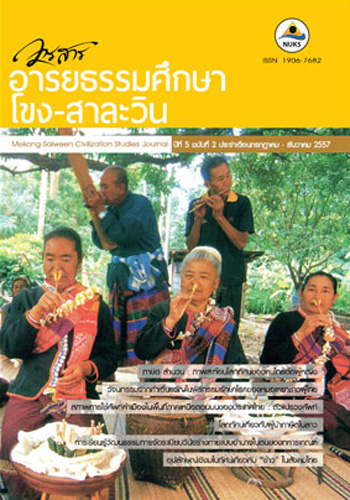สภาพการใช้ศัพท์คำเมืองในพื้นที่ภาคเหนือตอนบนของประเทศไทย : ตัวแปรวงศัพท์
Main Article Content
Abstract
บทความนี้เป็นส่วนหนึ่งของงานวิจัยเรื่องสภาพการใช้ศัพท์คำเมืองในเขตอำเภอเมืองของจังหวัดภาคเหนือตอนบน โดยในบทความนี้จะมุ่งเสนอผลการศึกษาสภาพการใช้ศัพท์คำเมืองในพื้นที่ภาคเหนือตอนบนในวงศัพท์ต่างๆ มีวิธีการเก็บข้อมูลโดยการนำหน่วยอรรถที่คัดเลือกไว้จำนวน 259 หน่วยอรรถไปสัมภาษณ์ผู้บอกภาษาที่มีคุณสมบัติตามหลักเกณฑ์ที่กำหนด จำนวน 144 คน ในพื้นที่ 8 จังหวัดภาคเหนือตอนบน จากนั้นนำข้อมูลที่ได้มาวิเคราะห์สภาพการใช้ศัพท์คำเมืองตามปัจจัยต่างๆโดยใช้ค่าร้อยละ และวิธีการทางสถิติแบบไค-สแควร์ (Chi-Square) ผลการศึกษาพบว่า ในพื้นที่ 8 จังหวัดภาคเหนือตอนบนมีสภาพการใช้ศัพท์คำเมืองในภาพรวม อยู่ในระดับ ค่อนข้างมาก (ร้อยละ 69.58) ในวงศัพท์หลัก หมวดคำอื่นๆมีสภาพการใช้ศัพท์คำเมืองอยู่ในระดับ มาก (ร้อยละ 87.21) รองลงมาคือหมวดคำกริยาและหมวดคำนามมีสภาพการใช้ศัพท์คำเมืองอยู่ในระดับ ค่อนข้างมาก (ร้อยละ 76.10 และ 64.22 ตามลำดับ) ในวงศัพท์ย่อย กลุ่มคำขยาย กลุ่มคำเชื่อมและคำเสริม และกลุ่มคำกริยาแสดงสภาพและการประสบ มีสภาพการใช้ศัพท์คำเมืองอยู่ในระดับ มาก (ร้อยละ 87.66 86.23 และ 85.28 ตามลำดับ) กลุ่มคำนามที่เกี่ยวกับคน กลุ่มคำกริยาแสดงอาการ กลุ่มคำนามที่เกี่ยวกับพืช กลุ่มคำนามที่เกี่ยวกับวันเวลา ธรรมชาติ สถานที่ และสิ่งปลูกสร้าง และกลุ่มคำนามที่เกี่ยวกับสัตว์ มีสภาพการใช้ศัพท์คำเมืองอยู่ในระดับ ค่อนข้างมาก (ร้อยละ 71.00 68.97 68.21 64.95 และ 64.53 ตามลำดับ) และกลุ่มคำนามที่เกี่ยวกับสิ่งของเครื่องใช้ มีสภาพการใช้ศัพท์คำเมืองอยู่ในระดับ ปานกลาง (ร้อยละ 54.91) เมื่อวิเคราะห์ความสัมพันธ์ระหว่างวงศัพท์กับสภาพการใช้ศัพท์คำเมืองโดยใช้วิธีการทางสถิติแบบไค-สแควร์ (Chi-Square) พบว่า วงศัพท์มีความสัมพันธ์กับสภาพการใช้ศัพท์คำเมืองอย่างมีนัยสำคัญทางสถิติ
State of Using Kham Muang Vocabulary in the Upper Northern Thailand: Lexical field
This study investigates and classifies the factor affecting usage of Kham Muang Vocabulary in the Upper Northern Thailand. The factor is lexical field. The data are 259 lexeme collected from interviews with 144 informants in the 8 Upper Northern provinces of Thailand. The factor affecting usage of Kham Muang Vocabulary was analyzed using percentage and chi-squared tests. The findings show that in the 8 upper Northern provinces of Thailand, the overall usage of Northern Thai is moderately high (69.58 percent). In the main lexical field, the category of 'other' was found at a high level (87.21 percent), followed by the categories of verbs and nouns, which were moderately high (76.10 and 64.22 percent, respectively). In the sub-lexical field, 3 collections of word types are identified. These are: modifiers; conjunctions and particles; and stative and cognitive verbs, which were observed at a high level (87.66, 86.23 and 85.28 percent, respectively). 5 collections of word types are identified. These are: nouns related to people; action verbs; nouns related to plants; nouns related time, nature, place and the built environment; and nouns related to animals, which were observed at a moderately high level (71.00, 68.97, 68.21, 64.95, and 64.53 percent, respectively). Nouns related to supplies and equipment were observed at moderate level (54.91 percent). In the overall chi-squared analysis, on the relationship between lexical field and the state of using Kham Muang Vocabulary, the lexical field of the informants showed a statistically significant correlation.


